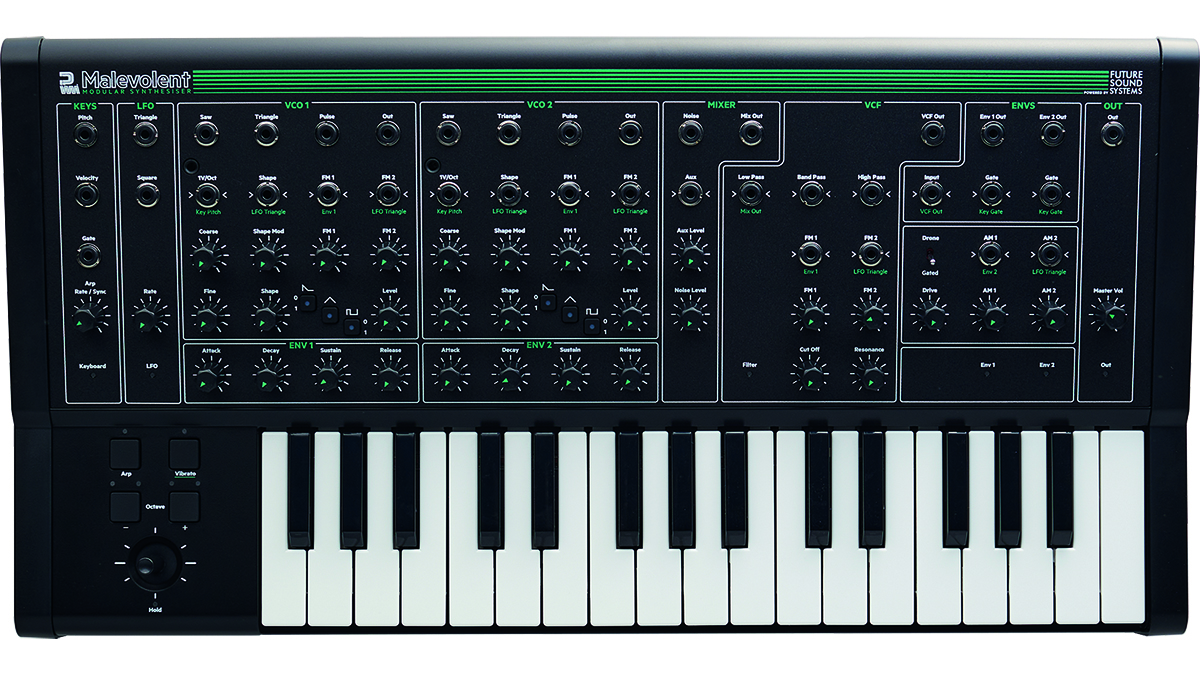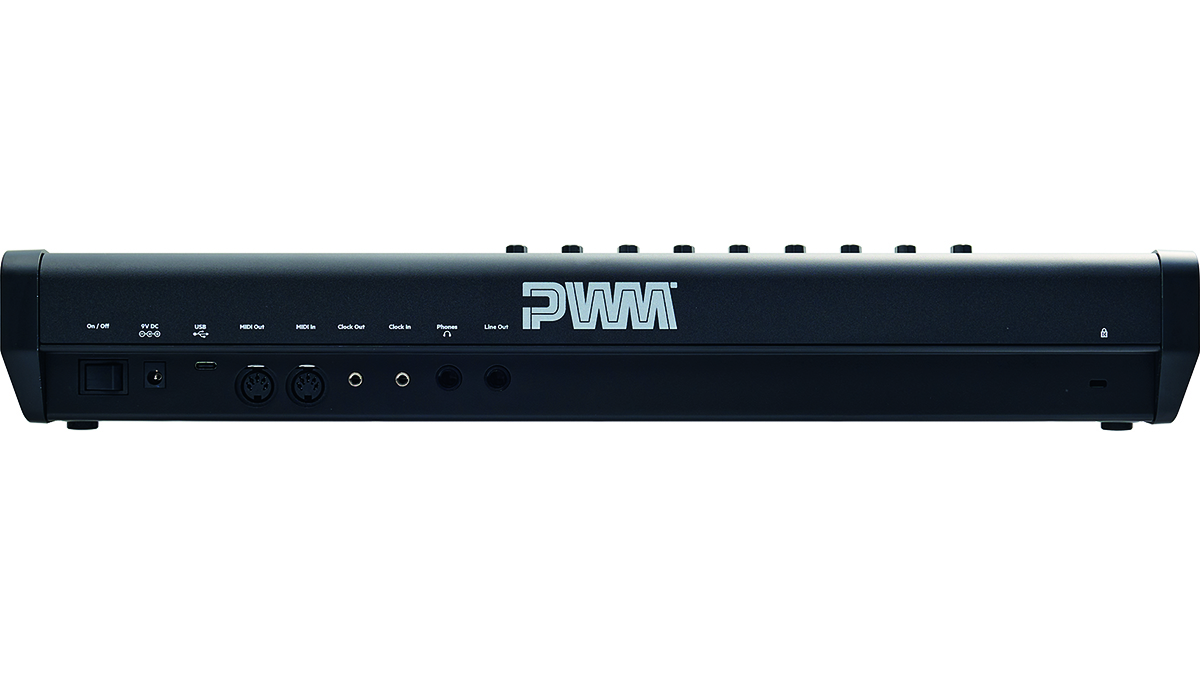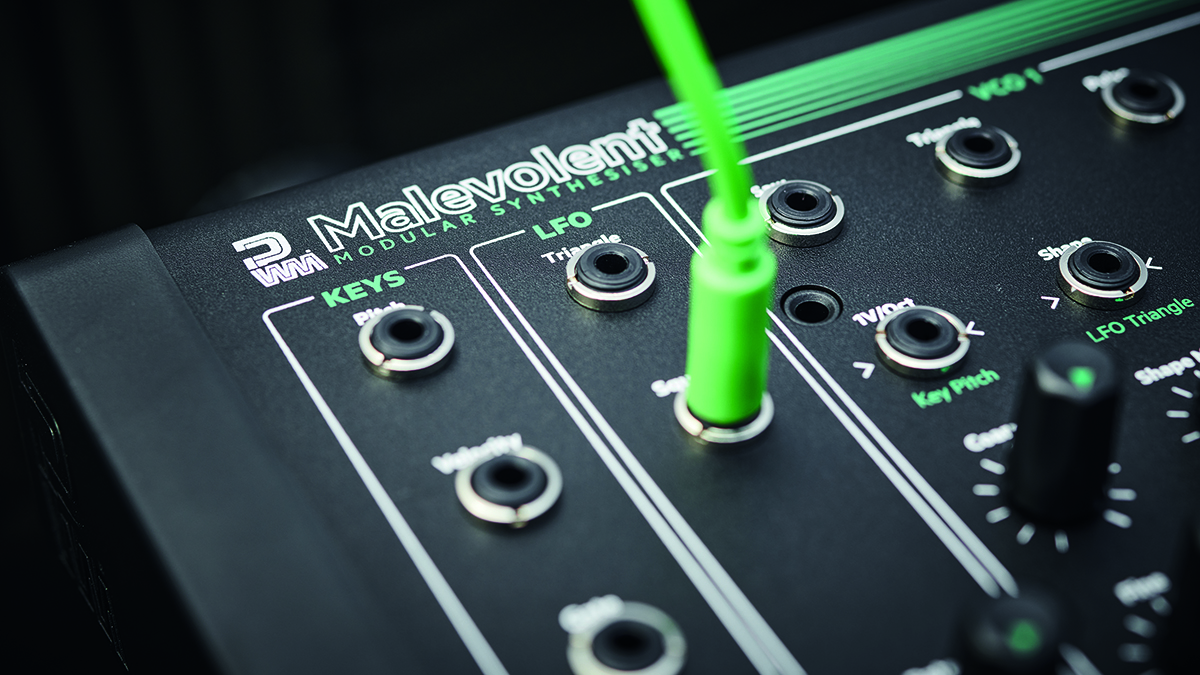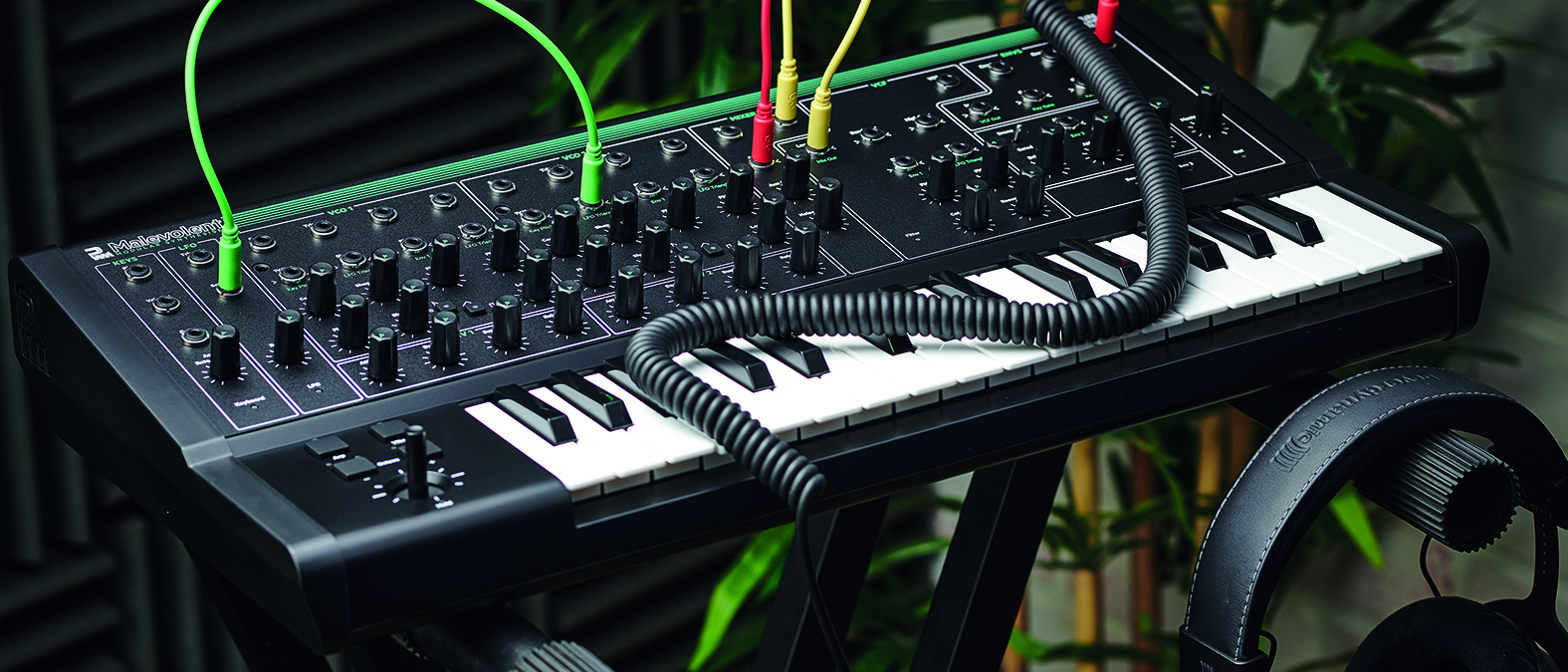MusicRadar Verdict
A bold and characterful debut and very much worth your attention, although its vintage ethos occasionally limits its versatility.
Pros
- +
Wonderfully characterful and raw sound.
- +
Neat, knob-per-function interface.
- +
Pairs very well with other modular/semi-modular gear.
Cons
- -
Joystick implementation is slightly questionable.
- -
No patchable utilities.
- -
No sync/trigger for the LFO.
MusicRadar's got your back
PWM Malevolent: What is it?
Malevolent may be the debut instrument from equally new British outfit PWM, but it nevertheless arrives with a substantial design pedigree. The analogue electronics were developed alongside Bristol’s Future Sound Systems, and its design team includes ex-Focusrite, Avid, M-Audio and Roli employees.
It’s described by its creator as a ‘pure analogue semi-modular’, meaning that, while there are digital control elements and MIDI implementation, the sound engine is all-analogue from start to finish. We're often wary of instruments that boast analogue purity for the sake of it but Malevolent is a proudly old-school piece of instrument design that wears its gritty, retro heart on its sleeve.

Those retro-leanings are evident from the moment you take the synth out of the box. With its subtle black, white and green styling and neatly laid out knob-per-function interface, Malevolent has a look akin to some forgotten synth from the late-’70s or early-’80s; more like a contemporary of the MS-10 than something released in 2022. The only hints that this is a modern piece of hardware are the MIDI and USB I/O tucked away on the rear panel.
The hardware itself is a little lighter than its vintage inspirations would have been but feels sturdy and well made. There’s a 32-note mini keyboard, which has a fairly basic, plasticky feel to it, but does feature (patchable) velocity.
To the left of the keyboard sits a joystick that adds to the retro feel of the design and can be used for expression and pitch bends. The synth comes with optional metal end cheeks, which are simple to attach or can be left off for easier mounting options.

PWM Malevolent: Performance and verdict
In classic monosynth fashion, the composition of the sound engine is fairly straightforward. There are two VCOs, each with saw, triangle and square wave outputs, a mixer section, where these can be blended with an auxiliary input and white noise generator, a resonant 2-pole filter, an amp section with overdrive, two ADSR envelopes and an LFO.
It’s standard fare for an analogue monosynth, but while it might sound conventional on paper, Malevolent sets itself apart due to the sheer wealth of character offered by many of these elements.
The two VCO sections are pretty much identical. Each has patchable outputs for each of its three wave types, plus front panel buttons to engage each type within the internally patched signal path.
There are coarse and fine tuning controls, along with a shape parameter that can alter the basic waveshapes by, for example, adjusting the pulse width of the square wave or adding square-like harmonics to the triangle.

• Arturia MiniBrute 2
The more feature-rich MiniBrute looks better value on paper, but in terms of sonic character, there’s much to love about either synth.
• Korg Monologue
Korg’s monosynth forgoes the semi-modular patchability of Malevolent but boasts numerous modern conveniences and a bargain price.
• Behringer Neutron
Behringer’s desktop semi lacks a keyboard but has plenty of patch points and a similarly raw and edgy sound.
Each oscillator also gets a trio of modulation controls, the first of which controls the oscillator shape parameter, the remaining two modulating the oscillator frequency. Each of these have pre-patched internal routings – both Shape and FM 2 from the triangle wave LFO, FM 1 from Envelope 1 – but each also has its own front panel patch point, allowing for a variety of modulation configurations ranging from slow shifts in timbre to audio-rate effects.
Even used in isolation, there’s a fantastic range of tones available from these oscillators. Blending wave types and modulating the shape parameter can quickly take the sound from muted and bassy to raspy with lots of rich harmonics. Combined with a little detuning or modulation between the two VCOs, Malevolent can create some immense sounds, even without the inclusion of a sub oscillator.
The oscillators feed into a VCF, which once again oozes character. This is a resonant, 2-pole Sallen-Key filter. The internal signal path has the mixer output patched into the filter in low-pass mode, but separate front panel inputs allow the filter to be patched in low-, high- and band-pass configurations.
While having a single filter with just a 12dB slope option is a little limited in contrast to some comparable monosynths, it is possible to use those three mode inputs simultaneously, which can be a lot of fun when designing patches.
Some of our favourite sounds created while testing Malevolent involve patching different elements – such as individual oscillators or the noise source – separately into the low- and high-pass inputs, then using the cutoff to blend between timbres. This works particularly well for evolving drones and FX.

The filter’s character really kicks into gear with the resonance. Even a slight bump can have a noticeable impact on the final sound, and at higher levels it will really scream and squelch before pushing into self-oscillation. It sounds fantastic for squelchy acid-style basslines – capable of raspy resonance without losing low-end impact.
This all works particularly well coupled with the drive circuit, which is particularly meaty-sounding and can add really pleasing grit to sounds, albeit with an accompanying volume boost that you’ll need to watch out for.
Being semi-modular, you can also route one of the additional outputs back into the sound engine should you want a bit of extra feedback to give you a final touch of extra oomph. Taken together, we can’t think of another hardware synth we’ve tried in recent years that sounds quite so good for aggressive dance music basslines without the need for much external processing.
The onboard modulation options are relatively basic. The two envelopes are identical ADSR designs. Each has a patch point for its output as well as a gate input, but there’s no looping functionality or modulation for individual envelope stages.
The LFO is similarly no-frills, with rate control and individual outputs for triangle and square waves, but no way to retrigger or randomise the LFO, or even sync it to a clock source.
This is one area where Malevolent’s old-school ethos is a little basic by modern standards. The same could be said for the patching capabilities – while there are ins and outs included for most synth elements, it lacks any form of utility, like patchable attenuators, a splitter/mixer or a sample & hold generator.

Arp on
There’s no onboard sequencer here, but Malevolent does include an arpeggiator offering six pattern types and a six-octave range, selectable using the joystick and octave buttons.
Speed is controlled using a front panel rate control. As soon as Malevolent is fed a clock source through its MIDI or its analogue input, the arp will sync to that signal, and the rate control becomes a clock divider.
The front panel also has outs for keyboard velocity, pitch and gate, meaning that the arp and keys can be easily patched to control just one oscillator individually – for paraphonic playing or sequencing – or any external CV gear.
Brute-ish
Given its price point and general design, Malevolent invites obvious comparisons with Arturia’s similarly-spec’d MiniBrute 2. On paper at least, such a comparison isn’t necessarily favourable to PWM’s synth.
At the time of writing you can pick up a MiniBrute for around £40 cheaper than Malevolent in the UK, and the Arturia synth boasts features including expanded LFO functionality, patchable utilities and a sequencer.
Malevolent invites obvious comparisons with Arturia’s similarly-spec’d MiniBrute 2
This is a comparison that only really holds on paper. Judged on a feature-to-feature level, Malevolent is certainly a less versatile synth than some others at this price point, but to write it off as such would overlook the appeal of its characterful sound.
As is the case with many of the vintage instruments that have clearly inspired Malevolent, you can’t really judge it purely on its list of features. Having used both the MiniBrute and Malevolent side-by-side it’s fair to say that both have enough distinctive character that it’s not simply an either/or choice between the two.
The one element of Malevolent’s design that breaks with the all-analogue vibe is its joystick – still a retro touch, but one closer to the early digital instruments of the ’80s and ’90s. This performs several functions at once – moved left or right on its X axis, it applies pitch bends.
The top half of the Y axis, meanwhile, is used to apply varying degrees of either vibrato or portamento, with a button above to switch between the two modes. All of this works well. We wouldn’t have minded the option of a rotary for portamento too – as it can be nice to dial in and forget about – but being able to perform glides while playing the keyboard works nicely.
The lower half of the Y axis is used as a hold/latch for the keyboard and arp, either as a momentary function by holding the joystick down or fully engaged by pushing it in like a button.
It’s arguably an odd choice to assign a simple on/off function like this to an expressive controller like the joystick, especially seeing as portamento and vibrato have to share. Why not apply pitch bends, portamento and vibrato to the four poles of the joystick and use the mode switch button as a hold on/off?
This one eccentricity aside, we’ve been very much won over by Malevolent, with its raw, edgy and distinctive sound. There are definitely more versatile monosynths at this price point, although the semi-modular nature lends itself to expandability.
We’ve found ourselves using Malevolent with other patchable gear to get around that lack of utilities, which naturally opens up a whole world of fresh ideas. Here’s hoping that PWM’s next step is to bring out a Eurorack-compatible module version. In its current form though, this is a bold, distinctive and very welcome debut for PWM.
MusicRadar verdict: A bold and characterful debut and very much worth your attention, although its vintage ethos occasionally limits its versatility.
PWM Malevolent: The web says
"It’s well thought-out, well made and offers plenty of sonic versatility, but above all else it’s got character."
Juno Daily
PWM Malevolent: Hands-on demos
PWMusic
Andertons Synths, Keys and Tech
BoBeats
Starsky Carr
PWM Malevolent: Specifications
- KEY FEATURES: Semi-modular ‘all analogue’ monosynth (patchable for paraphonic use). 32-note velocity-sensitive mini keyboard with arpeggiator.
- I/O: Line out, headphone out, MIDI in and out, USB MIDI, analogue clock in and out, 19-in/19-out front panel patchbay.
- DIMENSIONS: 690 x 320 x 160 mm.
- WEIGHT: 3.7kg.
- CONTACT: PWM
I'm the Managing Editor of Music Technology at MusicRadar and former Editor-in-Chief of Future Music, Computer Music and Electronic Musician. I've been messing around with music tech in various forms for over two decades. I've also spent the last 10 years forgetting how to play guitar. Find me in the chillout room at raves complaining that it's past my bedtime.
“Delivers streamlined DAW integration with an excellent hammer action keyboard”: Arturia Keylab 88 Mk3 review
“I have an original 909 – every time I try to use it I feel like I’m ruining it”: House hero Riva Starr on his studio essentials and his love of analogue synths
“A synthesizer that is both easy to use and fun to play whilst maintaining a decent degree of programming depth and flexibility”: PWM Mantis review










